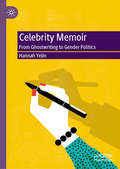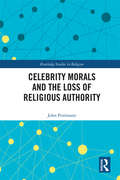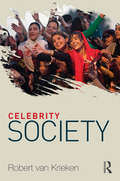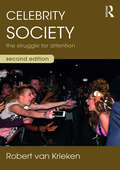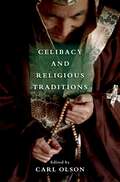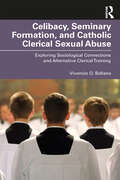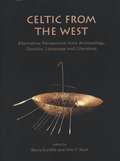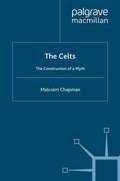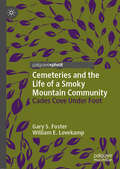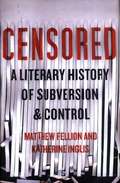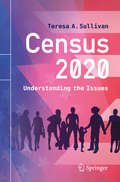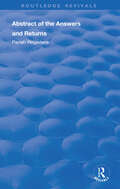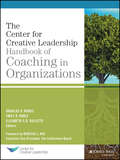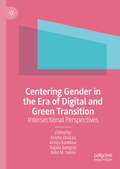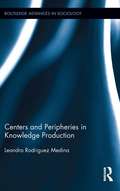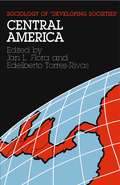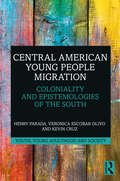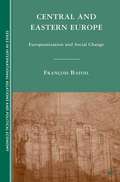- Table View
- List View
Celebrity Memoir: From Ghostwriting to Gender Politics
by Hannah YelinIn this timely analysis of the economics of access that surround contemporary female celebrity, Hannah Yelin reveals a culture that requires women to be constantly ‘baring all’ in physical exposure and psychic confessions. As famous women tell their story, in their ‘own words’, constellations of ghostwriters, intermediaries and market forces undermine assertions of authorship and access to the ‘real’ woman behind the public image. Yelin’s account of the presence of the ghostwriter offers a fascinating microcosm of the wider celebrity machine, with insights pertinent to all celebrity mediation. Yelin surveys life-writing genres including fiction, photo-diary, comic-strip, and art anthology, as well as more ‘traditional’ autobiographical forms; covering a wide range of media platforms and celebrity contexts including reality TV, YouTube, pop stardom, and porn/glamour modelling. Despite this diversity, Yelin reveals seemingly inescapable conventions, as well as spaces for resistance. Celebrity Memoir: from Ghostwriting to Gender Politics offers new insights on the curtailment of women’s voices, with ramifications for literary studies of memoir, feminist media studies, celebrity studies, and work on the politics of production in the creative industries.
Celebrity Morals and the Loss of Religious Authority (Routledge Studies in Religion)
by John PortmannThis book examines American popular culture to demonstrate that celebrities have superseded religious figures as moral authorities. As trust in religious institutions has waned over recent decades, the once frivolous entertainment fringe has become the moral center. Young people and voters increasingly take cues from actors and athletes. The book begins by offering a definition of celebrity and showing that the profile of celebrities has changed dramatically, particularly since the 1960s. They can now chart their own careers, manage their own personal lives and weigh in on pressing moral issues in a manner that hasn’t always been the case. This can be to the good, it is argued, for some counterintuitive reasons. Very few stars pretend to be moral exemplars, unlike the frequently hypocritical elites they have replaced. Others, however, are seemingly poorly qualified to speak on complex moral issues. In the end, it also turns out that who tells us how to feel about any moral issue counts at least as much as what they tell us. This is a fresh look at the impact of celebrity culture on contemporary morality and religious authority. As such, it will be of great use to academics working in religious studies and ethics, as well as popular culture and media studies.
Celebrity Morals and the Loss of Religious Authority (Routledge Studies in Religion)
by John PortmannThis book examines American popular culture to demonstrate that celebrities have superseded religious figures as moral authorities. As trust in religious institutions has waned over recent decades, the once frivolous entertainment fringe has become the moral center. Young people and voters increasingly take cues from actors and athletes. The book begins by offering a definition of celebrity and showing that the profile of celebrities has changed dramatically, particularly since the 1960s. They can now chart their own careers, manage their own personal lives and weigh in on pressing moral issues in a manner that hasn’t always been the case. This can be to the good, it is argued, for some counterintuitive reasons. Very few stars pretend to be moral exemplars, unlike the frequently hypocritical elites they have replaced. Others, however, are seemingly poorly qualified to speak on complex moral issues. In the end, it also turns out that who tells us how to feel about any moral issue counts at least as much as what they tell us. This is a fresh look at the impact of celebrity culture on contemporary morality and religious authority. As such, it will be of great use to academics working in religious studies and ethics, as well as popular culture and media studies.
Celebrity Society
by Robert Van KriekenOn television, in magazines and books, on the internet and in films, celebrities of all sorts seem to monopolize our attention. Celebrity Society brings new dimensions to our understanding of celebrity, capturing the way in which the figure of ‘the celebrity’ is bound up with the emergence of modernity. It outlines how the ‘celebrification of society’ is not just the twentieth-century product of Hollywood and television, but a long-term historical process, beginning with the printing press, theatre and art. By looking beyond the accounts of celebrity ‘culture’, Robert van Krieken develops an analysis of ‘celebrity society’, with its own constantly changing social practices and structures, moral grammar, construction of self and identity, legal order and political economy organized around the distribution of visibility, attention and recognition. Drawing on the work of Norbert Elias, the book explains how contemporary celebrity society is the heir (or heiress) of court society, taking on but also democratizing many of the functions of the aristocracy. The book also develops the idea of celebrity as driven by the ‘economics of attention’, because attention has become a vital and increasingly valuable resource in the information age. This engaging new book will be a valuable resource for students and scholars in sociology, politics, history, celebrity studies, cultural studies, the sociology of media and cultural theory.
Celebrity Society
by Robert Van KriekenOn television, in magazines and books, on the internet and in films, celebrities of all sorts seem to monopolize our attention. Celebrity Society brings new dimensions to our understanding of celebrity, capturing the way in which the figure of ‘the celebrity’ is bound up with the emergence of modernity. It outlines how the ‘celebrification of society’ is not just the twentieth-century product of Hollywood and television, but a long-term historical process, beginning with the printing press, theatre and art. By looking beyond the accounts of celebrity ‘culture’, Robert van Krieken develops an analysis of ‘celebrity society’, with its own constantly changing social practices and structures, moral grammar, construction of self and identity, legal order and political economy organized around the distribution of visibility, attention and recognition. Drawing on the work of Norbert Elias, the book explains how contemporary celebrity society is the heir (or heiress) of court society, taking on but also democratizing many of the functions of the aristocracy. The book also develops the idea of celebrity as driven by the ‘economics of attention’, because attention has become a vital and increasingly valuable resource in the information age. This engaging new book will be a valuable resource for students and scholars in sociology, politics, history, celebrity studies, cultural studies, the sociology of media and cultural theory.
Celebrity Society: The Struggle for Attention
by Robert van KriekenOn television and in films, in magazines and books, on the Internet and in the realm of politics, celebrities of all sorts seem to dominate our attention. Celebrity Society: The Struggle for Attention brings new perspectives to our understanding of how the figure of ‘the celebrity’ is bound up with the structure and dynamics of society, economics, and politics. It outlines how the ‘celebrification of society’ is not just the twentieth-century product of Hollywood and television, but a long-term historical process, beginning with Christian saints, the printing press, theatre, and art. Drawing on the ideas of Norbert Elias, the book explains how contemporary celebrity society is the heir (or heiress) of ‘court society’, taking on but also transforming many of the functions of the aristocracy. As well as examining celebrity in all the familiar arenas – film, television, music, fashion, and sport – Celebrity Society also includes the analysis of celebrity in business and management, politics, humanitarianism, and philanthropy. A key feature of the book is its development of the idea that celebrity is driven by the ‘economy of attention’, since attention has become a form of capital – attention capital – in the Information and Internet age. In this second edition the author has updated and significantly revised this path-breaking book to include a more detailed discussion of attention capital, the question of gender and celebrity, populism, fans, fandom, and self-formation, micro-celebrity, and personal or self-branding, the ‘worker celebrity’, and the impact of social media such as Twitter, Facebook, Instagram, and YouTube. Celebrity is an exciting and rapidly expanding field of social science, making this engaging book a valuable resource for students and scholars in sociology, politics, history, celebrity studies, cultural studies, the sociology of media, and cultural theory.
Celebrity Society: The Struggle for Attention
by Robert van KriekenOn television and in films, in magazines and books, on the Internet and in the realm of politics, celebrities of all sorts seem to dominate our attention. Celebrity Society: The Struggle for Attention brings new perspectives to our understanding of how the figure of ‘the celebrity’ is bound up with the structure and dynamics of society, economics, and politics. It outlines how the ‘celebrification of society’ is not just the twentieth-century product of Hollywood and television, but a long-term historical process, beginning with Christian saints, the printing press, theatre, and art. Drawing on the ideas of Norbert Elias, the book explains how contemporary celebrity society is the heir (or heiress) of ‘court society’, taking on but also transforming many of the functions of the aristocracy. As well as examining celebrity in all the familiar arenas – film, television, music, fashion, and sport – Celebrity Society also includes the analysis of celebrity in business and management, politics, humanitarianism, and philanthropy. A key feature of the book is its development of the idea that celebrity is driven by the ‘economy of attention’, since attention has become a form of capital – attention capital – in the Information and Internet age. In this second edition the author has updated and significantly revised this path-breaking book to include a more detailed discussion of attention capital, the question of gender and celebrity, populism, fans, fandom, and self-formation, micro-celebrity, and personal or self-branding, the ‘worker celebrity’, and the impact of social media such as Twitter, Facebook, Instagram, and YouTube. Celebrity is an exciting and rapidly expanding field of social science, making this engaging book a valuable resource for students and scholars in sociology, politics, history, celebrity studies, cultural studies, the sociology of media, and cultural theory.
Celibacy and Religious Traditions
by Carl OlsonIf sexuality is inherently social, the same thing can be said about celibacy. An understanding of celibacy, argues Carl Olson, can be a useful way to view the significance of the human body within a social context. The purpose of this book is to examine how the practice of celibacy differs cross-culturally as well as historically within a particular religious tradition. The essays (all previously unpublished) will demonstrate that celibacy is a complex religious phenomenon. The control of sexual desire can be used to divorce oneself from a basic human biological drive, to separate oneself from what is perceived as impure, or to distance oneself from a transient world. Within different religious traditions there can be found the practice of temporary celibacy, commitment to long-term permanent celibacy, and outright condemnations of it. By maintaining a state of virginity, members of some religious traditions imitate divine models; other traditions do not admit the possibility of emulating such paradigms. Whether or not a religious tradition encourages or discourages it, the practice of celibacy gives us insight into its worldview, social values, gender relations, ethics, religious roles, and understanding of the physical body. Celibacy can contribute to the creation of a certain status and play a role in the construction of identity, while serving as a source of charisma. In some religious traditions, it is possible to renounce sex and gain sacred status and economic support from society. Each essay in the collection will be written by an expert in a particular religious tradition. Each will address such questions as: Why do some members of a religious community decide to maintain a celibate style of religious life? Is celibacy a prerequisite for religious office or status? Are there different contexts within a given religious tradition for the practice of celibacy? What does the choice of celibacy tell us about the human body in a particular religious culture? What is the symbolic significance of celibacy? What is its connection to the acquisition of power? What are its physical or spiritual benefits? The first collection of its kind, this book will be a valuable resource for courses in world religions, as well as a contribution to our understanding of this very widespread but puzzling human phenomenon.
Celibacy, Seminary Formation, and Catholic Clerical Sexual Abuse: Exploring Sociological Connections and Alternative Clerical Training (Routledge Studies in the Sociology of Religion)
by Vivencio O. BallanoDoes the current celibate, semi-monastic, and all-male seminary formation contribute to the persistence of clerical sexual abuse in the Roman Catholic Church?Applying sociological theories on socialization, total institutions, and social resistance as the primary conceptual framework, and drawing on secondary literature, media reports, the author’s experience, interviews, and Church documents, this book argues that the Catholic Church’s institution of the celibate seminary formation as the only mode of clerical training for Catholic priests has resulted in negative unintended consequences to human formation such as the suspension of normal human socialization in society, psychosexual immaturity, and weak social control against clerical sexual abuse. The author thus contends that celibate training, while suitable for those who do live in religious or monastic communities, is inappropriate for those who are obliged to live alone and work in parishes. As such, an alternative model for diocesan clerical formation is advanced.A fresh look at the aptness – and effects – of celibate formation for diocesan clergy, this volume is the first to relate the persistence of Catholic clerical sexual abuse to celibate seminary formation, exploring the structural links between the two using sociological arguments and proposing an apprenticeship-based model of formation, which has numerous advantages as a form of clerical training. It will therefore appeal to scholars and students of religion, sociology, and theology, as well as those involved with seminary formation.
Celibacy, Seminary Formation, and Catholic Clerical Sexual Abuse: Exploring Sociological Connections and Alternative Clerical Training (Routledge Studies in the Sociology of Religion)
by Vivencio O. BallanoDoes the current celibate, semi-monastic, and all-male seminary formation contribute to the persistence of clerical sexual abuse in the Roman Catholic Church?Applying sociological theories on socialization, total institutions, and social resistance as the primary conceptual framework, and drawing on secondary literature, media reports, the author’s experience, interviews, and Church documents, this book argues that the Catholic Church’s institution of the celibate seminary formation as the only mode of clerical training for Catholic priests has resulted in negative unintended consequences to human formation such as the suspension of normal human socialization in society, psychosexual immaturity, and weak social control against clerical sexual abuse. The author thus contends that celibate training, while suitable for those who do live in religious or monastic communities, is inappropriate for those who are obliged to live alone and work in parishes. As such, an alternative model for diocesan clerical formation is advanced.A fresh look at the aptness – and effects – of celibate formation for diocesan clergy, this volume is the first to relate the persistence of Catholic clerical sexual abuse to celibate seminary formation, exploring the structural links between the two using sociological arguments and proposing an apprenticeship-based model of formation, which has numerous advantages as a form of clerical training. It will therefore appeal to scholars and students of religion, sociology, and theology, as well as those involved with seminary formation.
Celtic From The West: Alternative Perspectives From Archaeology, Genetics, Language And Literature (PDF) (Celtic Studies Publications #15)
by John T. Koch Barry W. CunliffeThis book is an exploration of the new idea that the Celtic languages originated in the Atlantic Zone during the Bronze Age, approached from various perspectives pro and con, archaeology, genetics, and philology. This Celtic Atlantic Bronze Age theory represents a major departure from the long-established, but increasingly problematical scenario in which the story of the Ancient Celtic languages and that of peoples called Keltoì Celts are closely bound up with the archaeology of the Hallstatt and La Tène cultures of Iron Age west-central Europe. The Celtic from the West proposal was first presented in Barry Cunliffe's Facing the Ocean (2001) and has subsequently found resonance amongst geneticists. It provoked controversy on the part of some linguists, though is significantly in accord with John Koch's findings in Tartessian (2009). The present collection is intended to pursue the question further in order to determine whether this earlier and more westerly starting point might now be developed as a more robust foundation for Celtic studies. As well as having this specific aim, a more general purpose of Celtic from the West is to bring to an English-language readership some of the rapidly unfolding and too often neglected evidence of the pre-Roman peoples and languages of the western Iberian Peninsula. Celtic from the West is an outgrowth of a multidisciplinary conference held at the National Library of Wales in Aberystwyth in December 2008. As well as the 11 chapters, the book includes 45 distribution maps and a further 80 illustrations. The conference and collaborative volume mark the launch of a multi-year research initiative undertaken by the University of Wales Centre for Advanced Welsh and Celtic Studies [CAWCS]: Ancient Britain and the Atlantic Zone [ABrAZo]. Contributors: (Archaeology) Barry Cunliffe; Raimund Karl; Amìlcar Guerra; (Genetics) Brian McEvoy & Daniel Bradley; Stephen Oppenheimer; Ellen Rrvik; (Language & Literature) Graham Isaac; David Parsons; John T. Koch; Philip Freeman; Dagmar S. Wodtko.
The Celts: The Construction of a Myth
by M. ChapmanThe Celts are commonly considered to be one of the great peoples of Europe, with continuous racial, cultural and linguistic genealogy from the Iron Age to the modern-day 'Celtic fringe'. This book shows, in contrast, that the Celts, as they have been known and understood over two thousand years, are simply the 'other' of the dominant cultural and political traditions of Europe. It is this continuous 'otherness' which lends them apparent continuity and substance.
Cemeteries and the Life of a Smoky Mountain Community: Cades Cove Under Foot
by Gary S. Foster William E. LovekampIn one of the few studies to draw upon cemetery data to reconstruct the social organization, social change, and community composition of a specific area, this volume contributes to the growing body of sociohistorical examinations of Appalachia. The authors herein reconstruct the Cades Cove community in the Great Smoky Mountains of Tennessee, USA, a mountain community from circa 1818 to 1939, whose demise can be traced to the establishment of the Great Smoky Mountains National Park. By supplementing a statistical analysis of Cades Cove’s twenty-seven cemeteries, completed as a National Park Study (#GRSM-01120), with ethnographic examination, the authors reconstruct the community in detail to reveal previously overlooked social patterns and interactions, including insight into the death culture and death-lore of the Upland South. This work establishes cemeteries as window into (proxies of) communities, demonstrating the relevance of socio-demographic data presented by statistical and other analyses of gravestones for Appalachian Studies, Regional Studies, Cemetery Studies, and Sociology and Anthropology.
Censored: A Literary History Of Subversion And Control
by Inglis FellionThe list of books suppressed in the English language features the sacred and profane, poetic and pornographic, famous and infamous. A history of literary censorship is therefore a history not only of texts but of the authorities that have attempted to prevent their circulation: sovereigns, politicians, judges, prison officers, slaveholders, school governors, librarians, teachers, parents, students, editors and publishers. Censored deals with some of the most contentious and fascinating cases, including works now praised as literary masterpieces, such as James Joyce's Ulysses and Vladimir Nabokov's Lolita; as well as a troubling book about assassination that was implicated in a murder case. The books in this comprehensive study have been chosen to showcase the variety of suppressed literature, the methods and consequences of censorship, and landmarks in the history of free speech.
Census 2020: Understanding the Issues
by Teresa A. SullivanThe decennial Census is the US Government's largest statistical undertaking, and it costs billions of dollars in planning, execution, and analysis. From a statistical viewpoint, it is critical because it is the only database that maps every inhabitant into a geographic location. By constitutional mandate, census data are the basis for reapportioning the House of Representatives and the Electoral College. The states use census data to redistrict their state legislatures and often to redraw boundaries for local elections. Census data inform the distribution of over $1.5 trillion in federal funding during the decade. This book details the fundamentals and significance of the 2020 Census for the non-specialist reader. It covers why the Census is the only statistical activity required by the US Constitution, the challenges of working towards an accurate and complete count, and what political ramifications flow from this process. Concise, timely, and comprehensible, this book provides helpful real-life examples while also offering an overview of the entwined statistical and political issues that surround the Census.
Census Reports: Abstract of the Answers and Returns, Parish Registers (Routledge Revivals)
by John RickmanCensus Reports 1801.
The Center for Creative Leadership Handbook of Coaching in Organizations (J-B CCL (Center for Creative Leadership))
by Douglas Riddle Emily R. Hoole Elizabeth C. GulletteEffect better outcomes with a robust coaching program The CCL Handbook of Coaching in Organizations deals with the practical, ethical, and political challenges of coaching within an organization. From coaching superiors to coaching business teams, this book outlines the Center for Creative Leadership (CCL) approach to professional coaching to help readers better manage leadership development and talent management program outcomes. With expert guidance on the key functions of human resources, learning and development, and organizational development, readers will gain insight into the issues associated with coaching program implementation and management, and the use of internal versus external coaches. Coverage includes a wide range of coaching-based services used in most large organizations, with practical advice on creating the right programs for maximum impact within the available budget. Professional development is a hot topic and plays a key role in attracting and retaining the best talent. Coaching is a broad area within the field, encompassing a range of services and goals, with varied expectations and requirements. This book provides actionable guidance for those designing, initiating, and implementing coaching programs, with new approaches and techniques that drive better outcomes. Provide direct coaching within an organization Manage coaching systems and programs Initiate and lead mentoring and peer-coaching programs Manage external coaches, and deal effectively with coaching suppliers An ideal coaching program must balance need with budget and be tailored to the requirements and resources of both the organization and the participants. It's a complex undertaking, but the right strategy and planning can lead to even better than expected outcomes. For the human resources professional who wants to strengthen an organization's coaching program, CCL Handbook of Coaching in Organizations is a thoughtful reference for a specialized function.
The Center for Creative Leadership Handbook of Coaching in Organizations (J-B CCL (Center for Creative Leadership))
by Douglas Riddle Emily R. Hoole Elizabeth C. GulletteEffect better outcomes with a robust coaching program The CCL Handbook of Coaching in Organizations deals with the practical, ethical, and political challenges of coaching within an organization. From coaching superiors to coaching business teams, this book outlines the Center for Creative Leadership (CCL) approach to professional coaching to help readers better manage leadership development and talent management program outcomes. With expert guidance on the key functions of human resources, learning and development, and organizational development, readers will gain insight into the issues associated with coaching program implementation and management, and the use of internal versus external coaches. Coverage includes a wide range of coaching-based services used in most large organizations, with practical advice on creating the right programs for maximum impact within the available budget. Professional development is a hot topic and plays a key role in attracting and retaining the best talent. Coaching is a broad area within the field, encompassing a range of services and goals, with varied expectations and requirements. This book provides actionable guidance for those designing, initiating, and implementing coaching programs, with new approaches and techniques that drive better outcomes. Provide direct coaching within an organization Manage coaching systems and programs Initiate and lead mentoring and peer-coaching programs Manage external coaches, and deal effectively with coaching suppliers An ideal coaching program must balance need with budget and be tailored to the requirements and resources of both the organization and the participants. It's a complex undertaking, but the right strategy and planning can lead to even better than expected outcomes. For the human resources professional who wants to strengthen an organization's coaching program, CCL Handbook of Coaching in Organizations is a thoughtful reference for a specialized function.
Centering Gender in the Era of Digital and Green Transition: Intersectional Perspectives
by Kristie Drucza Amira Kaddour Sujata Ganguly Adel M. SareaThis edited volume examines the importance of centering gender in research and policymaking focused on climate change, environmental sustainability, and digital technology. Chapters unpack how the transition to a green and digital future affects various fields and industry sectors including STEM, agriculture, and energy, as well as why gender-transformative approaches—particularly the production and analysis of gender-inclusive disaggregated data—should be included in those transitions. The editors and authors also look at the positive impact of these considerations on economic growth and poverty eradication. Finally, this book presents an ideal/utopian view of what a gender-equal and inclusive world that has transitioned to green industries and embraced digital technologies might look like.This book will be of interest to scholars, researchers, students and policymakers across the Social Sciences including Sociology, Anthropology, Gender Studies, Science & Technology Studies, and Economics.
Centers and Peripheries in Knowledge Production (Routledge Advances in Sociology #115)
by Leandro Rodriguez MedinaThis book examines the circulation of knowledge within globalization, focusing on the differences between centers and peripheries of knowledge production in the social sciences. It explores not only how knowledge is appropriated in peripheral fields but also how foreign ideas shape those fields and the trajectories of scholars, and uses actor-network theory to explain circulation of knowledge as an extension of socio-technical networks that transcend borders.
Centers and Peripheries in Knowledge Production (Routledge Advances in Sociology)
by Leandro Rodriguez MedinaThis book examines the circulation of knowledge within globalization, focusing on the differences between centers and peripheries of knowledge production in the social sciences. It explores not only how knowledge is appropriated in peripheral fields but also how foreign ideas shape those fields and the trajectories of scholars, and uses actor-network theory to explain circulation of knowledge as an extension of socio-technical networks that transcend borders.
Central America (Sociology Of Developing Societies Ser.)
by Jan L. Flora Edelberto Torres-RivasAn examination of the background to conflicts in Central America through culture, politics and social conditions. It examines the obstacles to a transition to democracy, the political parties in the region, the role of export crops and the co-existence of indigenous and Spanish cultures.
Central American Young People Migration: Coloniality and Epistemologies of the South (Youth, Young Adulthood and Society)
by Henry Parada Veronica Escobar Olivo Kevin CruzThis book examines the social construction and representation of ‘youth on the move’ in the context of the migration process, using El Salvador, Guatemala, and Honduras as a case study to reinterpret the immigration process under the frameworks of coloniality and epistemologies of the South. The discussion surrounding Central American migrants has increased exponentially with the emergence of the caravans and the increased security measures along Mexican and US borders. Explicitly focused on the plight of children and young people, the examination of migration includes exploring the global context and dynamics that influence migratory trends and framing Central American migrant processes and youth strategies of survival and resistance. Contributing to existing conversations about the migration of people from Central America, this text seeks to understand the phenomenon’s roots. This book will interest scholars and students across the social sciences, particularly those studying the global dynamics of power, and migration and governance, as well as practitioners involved in decision-making with governments and international organizations.
Central American Young People Migration: Coloniality and Epistemologies of the South (Youth, Young Adulthood and Society)
by Henry Parada Veronica Escobar Olivo Kevin CruzThis book examines the social construction and representation of ‘youth on the move’ in the context of the migration process, using El Salvador, Guatemala, and Honduras as a case study to reinterpret the immigration process under the frameworks of coloniality and epistemologies of the South. The discussion surrounding Central American migrants has increased exponentially with the emergence of the caravans and the increased security measures along Mexican and US borders. Explicitly focused on the plight of children and young people, the examination of migration includes exploring the global context and dynamics that influence migratory trends and framing Central American migrant processes and youth strategies of survival and resistance. Contributing to existing conversations about the migration of people from Central America, this text seeks to understand the phenomenon’s roots. This book will interest scholars and students across the social sciences, particularly those studying the global dynamics of power, and migration and governance, as well as practitioners involved in decision-making with governments and international organizations.
Central and Eastern Europe: Europeanization and Social Change (The Sciences Po Series in International Relations and Political Economy)
by Chris Turner F. BafoilThe collapse of communism in 1989 paved the way for the reunification of the continent. This book analyzes the impact of the different dynamics of change since 1989 on public policy and on various economic and political sectors.
